Impacts of Onset Time of El Niño Events on Summer Rainfall over Southeastern Australia during 1980–2017
Abstract
1. Introduction
2. Data and Methods
2.1. Data
2.2. Methods
2.3. El Niño Event Classification
3. Results
3.1. Climatic Characteristics of Summer Precipitation over Subtropical Southeastern Australia
3.2. Possible Mechanism of the Rainfall Differences between Autumn and Winter El Niño Events
3.2.1. Composite Analysis for the Pacific SST Variability
- (1)
- In the autumn El Niño events, significant positive SST anomalies in the eastern equatorial Pacific (EEP) were larger, with the maximum anomaly 2.7 °C located within 120–140° W. A wide area of positive SST anomalies stretched southeastward from the eastern tropical Indian Ocean to Australia, and a considerable zone of positive SST anomalies covered the east of Australia. There are two significant negative anomaly zones in the Pacific Ocean. The northern branch extended northeastward from the Philippine Sea to the North Pacific, with a maximum value of −0.6 °C. The stronger southern branch stretching from New Zealand to South America along 30–40° S, with a wide-area maximum value of −0.9 °C;
- (2)
- In the winter El Niño events, the maximum anomaly was only 1.5 °C and in the central equatorial Pacific (CEP, within 160–170° W), exhibited weaker and smaller spatial scales than those during autumn El Niño. At the same time, the two negative anomaly branches in the Pacific Ocean all weakened and covered smaller areas, and negative SST anomalies were closer to Australia’s southeastern coast. The zonal and meridional gradient of SST in the Pacific were weaker in the winter El Niño events compared to their counterpart—in a normal year.
3.2.2. Composite Analysis for the Atmospheric Circulation Variability
3.3. Composite Analysis for Water Vapor Transport
4. Discussion
5. Conclusions
Author Contributions
Funding
Acknowledgments
Conflicts of Interest
References
- Kane, R.P. On the relationship of ENSO with rainfall over different parts of Australia. Aust. Meteorol. Mag. 1996, 46, 39–49. [Google Scholar]
- Murphy, B.F.; Timbal, B. A review of recent climate variability and climate change in southeastern Australia. Int. J. Climatol. 2008, 28, 859–879. [Google Scholar] [CrossRef]
- Pezza, A.B.; Burrant, T.; Simmonds, I.; Smith, I. Southern Hemisphere Synoptic Behavior in Extreme Phases of SAM, ENSO, Sea Ice Extent, and Southern Australia Rainfall. J. Clim. 2010, 21, 5566–5584. [Google Scholar] [CrossRef]
- Sturman, A.P.; Tapper, N.J. The Weather and Climate of Australia and New Zealand; Oxford University Press: Oxford, UK, 2006; Volume 438. [Google Scholar]
- Croke, J.; Reinfelds, I.; Thompson, C.; Roper, E. Macrochannels and their significance for flood-risk minimisation: Examples from southeast Queensland and New South Wales, Australia. Stoch. Environ. Res. Risk Assess. 2014, 28, 99–112. [Google Scholar] [CrossRef]
- Hendon, H.H.; Lim, E.P.; Arblaster, J.M.; Anderson, D.L.T. Causes and predictability of the record wet east Australian spring 2010. Clim. Dyn. 2014, 42, 1155–1174. [Google Scholar] [CrossRef]
- Lim, E.P.; Hendon, H.H. Understanding and predicting the strong Southern Annular Mode and its impact on the record wet east Australian spring 2010. Clim. Dyn. 2015, 44, 2807–2824. [Google Scholar] [CrossRef]
- Mcbride, J.L.; Nicholls, N. Seasonal relationships between Australian rainfall and the southern oscillation. Mon. Weather Rev. 1983, 111, 1998–2004. [Google Scholar] [CrossRef]
- Karoly, D.J. Southern Hemisphere circulation features associated with El Niño–Southern Oscillation events. J. Clim. 1989, 2, 1239–1252. [Google Scholar] [CrossRef]
- Power, S.; Casey, T.; Folland, C.; Colman, A.; Mehta, V. Inter-decadal modulation of the impact of ENSO on Australia. Clim. Dyn. 1999, 15, 319–324. [Google Scholar] [CrossRef]
- Harangozo, S. A search for ENSO teleconnections in the west Antarctic Peninsula climate in austral winter. Int. J. Climatol. 2000, 20, 663–679. [Google Scholar] [CrossRef]
- Wang, G.; Hendon, H.H. Sensitivity of Australian rainfall to inter–El Nino variations. J. Clim. 2007, 20, 4211–4226. [Google Scholar] [CrossRef]
- Ashok, K.; Guan, Z.; Yamagata, T. Influence of the Indian Ocean Dipole on the Australian winter rainfall. Geophys. Res. Lett. 2003, 30, 1329. [Google Scholar] [CrossRef]
- Acworth, R.I.; Rau, G.C.; Cuthbert, M.O.; Jensen, E.; Leggett, K. Long-term spatio-temporal precipitation variability in arid-zone Australia and implications for groundwater recharge. Hydrogeol. J. 2016, 24, 1–17. [Google Scholar] [CrossRef]
- Cai, W.J.; Van Rensch, P.; Cowan, T.; Hendon, H.H. An asymmetry in the IOD and ENSO teleconnection pathway and its impact on Australian climate. J. Clim. 2011, 25, 6318–6329. [Google Scholar] [CrossRef]
- Ihara, C.; Kushnir, Y.; Cane, M.A.; De La Pena, V.H. Indian summer monsoon rainfall and its link with ENSO and Indian Ocean climate indices. Int. J. Climatol. 2007, 27, 179–187. [Google Scholar] [CrossRef]
- Meyers, G.; McIntosh, P.; Pigot, L.; Pook, M. The years of El Nino, La Nina, and interactions with the tropical Indian Ocean. J. Clim. 2007, 20, 2872–2880. [Google Scholar] [CrossRef]
- Verdon, D.C.; Franks, S.W. Long-term behaviour of ENSO: Interactions with the PDO over the past 400 years inferred from paleoclimate records. Geophys. Res. Lett. 2006, 33, 272–288. [Google Scholar] [CrossRef]
- Meneghini, B.; Simmonds, I.; Smith, I.N. Association between Australian rainfall and the southern annular mode. Int. J. Climatol. 2007, 27, 109–121. [Google Scholar] [CrossRef]
- Hendon, H.H.; Thompson, D.W.J.; Wheeler, M.C. Australian rainfall and surface temperature variations associated with the southern hemisphere annular mode. J. Clim. 2007, 20, 2452–2467. [Google Scholar] [CrossRef]
- Lim, E.P.; Hendon, H.H.; Arblaster, J.M.; Delage, F.; Nguyen, H.; Min, S.K.; Wheeler, M.C. The impact of the southern annular mode on future changes in southern hemisphere rainfall. Geophys. Res. Lett. 2016, 43, 7160–7167. [Google Scholar] [CrossRef]
- Thompson, D.W.J.; Wallace, J.M. Annular modes in the extratropical circulation. part I: Month-to-month variability. J. Clim. 2000, 13, 1000–1016. [Google Scholar] [CrossRef]
- Xie, Z.Y.; Huete, A.; Restrepo-Coupe, N.; Ma, X.L.; Devadas, R.; Caprarelli, G. Spatial partitioning and temporal evolution of Australia’s total water storage under extreme hydroclimatic impacts. Remote Sens. Environ. 2016, 183, 43–52. [Google Scholar] [CrossRef]
- Ropelewski, C.F.; Halpert, M.S. Global and regional scale precipitation patterns associated with the El Niño/Southern Oscillation. Mon. Weather Rev. 1987, 115, 1606–1626. [Google Scholar] [CrossRef]
- McPhaden, M.J.; Zebiak, S.E.; Glantz, M.H. ENSO as an integrating concept in earth science. Science 2006, 314, 1740–1745. [Google Scholar] [CrossRef] [PubMed]
- Gallant, A.J.E.; Kiem, A.S.; Verdon-Kidd, D.C.; Stone, R.C.; Karoly, D.J. Understanding hydroclimate processes in the Murray-Darling Basin for natural resources management. Hydrol. Earth Syst. Sci. 2012, 16, 2049–2068. [Google Scholar] [CrossRef]
- Taschetto, A.S.; England, M.H. El Niño Modoki impacts on Australian rainfall. J. Clim. 2009, 22, 3167–3174. [Google Scholar] [CrossRef]
- Zhu, Z.W. Breakdown of the Relationship between Australian Summer Rainfall and ENSO Caused by Tropical Indian Ocean SST Warming. J. Clim. 2018, 31, 2321–2336. [Google Scholar] [CrossRef]
- Hendon, H.H.; Lim, E.-P.; Liu, G. The role of air–sea interaction for prediction of Australian summer monsoon rainfall. J. Clim. 2012, 25, 1278–1290. [Google Scholar] [CrossRef]
- Yasunari, T. Zonally propagating modes of the global east-west circulation associated with the Southern Oscillation. J. Meteorol. Soc. Jpn. 1985, 63, 1013–1029. [Google Scholar] [CrossRef]
- Fu, C.B.; Diaz, H.F.; Fletcher, J.O. Characteristics of the response of sea surface temperature in the central Pacific associated with warm episodes of the Southern Oscillation. Mon. Weather Rev. 1986, 114, 1716–1738. [Google Scholar] [CrossRef]
- Quinn, W.H.; Neal, V.T. El Niño occurrences over the past four and a half centuries. J. Geophys. Res. 1987, 92, 14449–14461. [Google Scholar] [CrossRef]
- Enfield, D.B.; Cid, L.S. Low-frequency changes in El Niño–Southern Oscillation. J. Clim. 1991, 4, 1137–1146. [Google Scholar] [CrossRef]
- Wang, S. Reconstruction of El Niño event chronology for the last 600-year period. Acta Meteorol. Sin. 1992, 6, 47–57. (In Chinese) [Google Scholar]
- Xu, J.J.; Chan, J.C.L. The role of the Asian-Australian monsoon system in the onset time of El Niño events. J. Clim. 2001, 14, 418–433. [Google Scholar] [CrossRef]
- Timmermann, A.; An, S.I.; Kug, J.S.; Jin, F.F.; Cai, W.J.; Capotondi, A.; Cobb, K.; Lengaigne, M.; McPhaden, M.J.; Stuecker, M.F.; et al. El Niño–Southern Oscillation complexity. Nature 2018, 559, 535–545. [Google Scholar] [CrossRef]
- Brown, J.N.; Mcintosh, P.C.; Pook, M.J.; Risbey, J.S. An Investigation of the Links between ENSO Flavors and Rainfall Processes in Southeastern Australia. Mon. Weather Rev. 2009, 137, 3786–3795. [Google Scholar] [CrossRef]
- Hirahara, S.; Ishii, M.; Fukuda, Y. Centennial-scale sea surface temperature analysis and its uncertainty. J. Clim. 2014, 27, 57–75. [Google Scholar] [CrossRef]
- Kalnay, E.; Kanamitsu, M.; Kistler, R.; Collins, W.; Deaven, D.; Gandin, L.; Iredell, M.; Saha, S.; White, G.; Woollen, J.; et al. The NCEP/NCAR 40-year reanalysis project. Bull. Am. Meteorol. Soc. 1996, 77, 437–470. [Google Scholar] [CrossRef]
- Lee, H.T.; Gruber, A.; Ellingson, R.G.; Laszlo, I. Development of the HIRS Outgoing Longwave Radiation climate data set. J. Atmos. Ocean. Technol. 2007, 24, 2029–2047. [Google Scholar] [CrossRef]
- Fan, L.L.; Xu, J.J.; Guan, H.D. Impacts of Different Onset Time El Niño Events on Winter Rainfall over South China. Atmosphere 2018, 9, 366. [Google Scholar] [CrossRef]
- Sun, J.Q.; Wang, H.J.; Yuan, W. A possible mechanism for the co-variability of the boreal spring Antarctic Oscillation and the Yangtze River valley summer rainfall. Int. J. Climatol. 2009, 29, 1276–1284. [Google Scholar] [CrossRef]
- Lim, E.P.; Hendon, H.H. Causes and Predictability of the Negative Indian Ocean Dipole and Its Impact on La Nina During 2016. Sci. Rep. 2017, 7, 12619. [Google Scholar] [CrossRef] [PubMed]
- Michael, A.B.; Gail, P. Physics of Radiation and Climate; CRC Press: Boca Raton, FL, USA, 2015; p. 151. [Google Scholar]
- Risbey, J.S.; Pook, M.J.; McIntosh, P.C.; Wheeler, M.C.; Hendon, H.H. On the remote drivers of rainfall variability in Australia. Mon. Weather Rev. 2009, 137, 3233–3253. [Google Scholar] [CrossRef]
- Mo, K.C.; Higgins, R.W. The Pacific-South American modes and tropical convection during the Southern Hemisphere winter. Mon. Weather Rev. 1998, 126, 1581–1596. [Google Scholar] [CrossRef]
- Yeo, S.R.; Kim, K.Y. Decadal changes in the Southern Hemisphere sea surface temperature in association with El Niño–Southern Oscillation and Southern Annular Mode. Clim. Dyn. 2015, 45, 3227–3242. [Google Scholar] [CrossRef]
- Weng, H.; Behera, S.K.; Yamagata, T. Anomalous winter climate conditions in the Pacific rim during recent El Niño Modoki and El Niño events. Clim. Dyn. 2009, 32, 663–674. [Google Scholar] [CrossRef]
- Rauniyar, S.P.; Walsh, K.J.E. Influence of ENSO on the Diurnal Cycle of Rainfall over the Maritime Continent and Australia. J. Clim. 2013, 26, 1304–1321. [Google Scholar] [CrossRef]
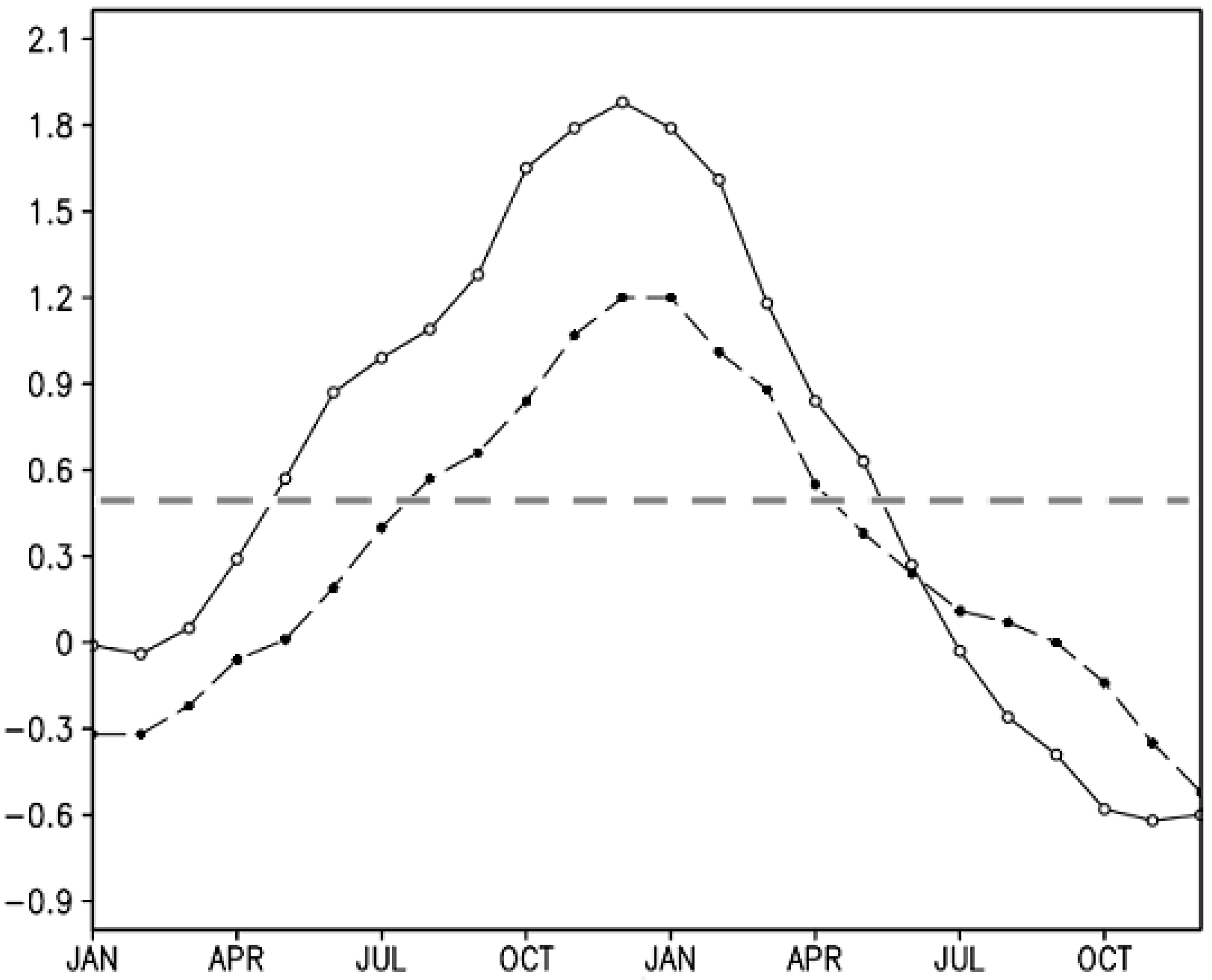
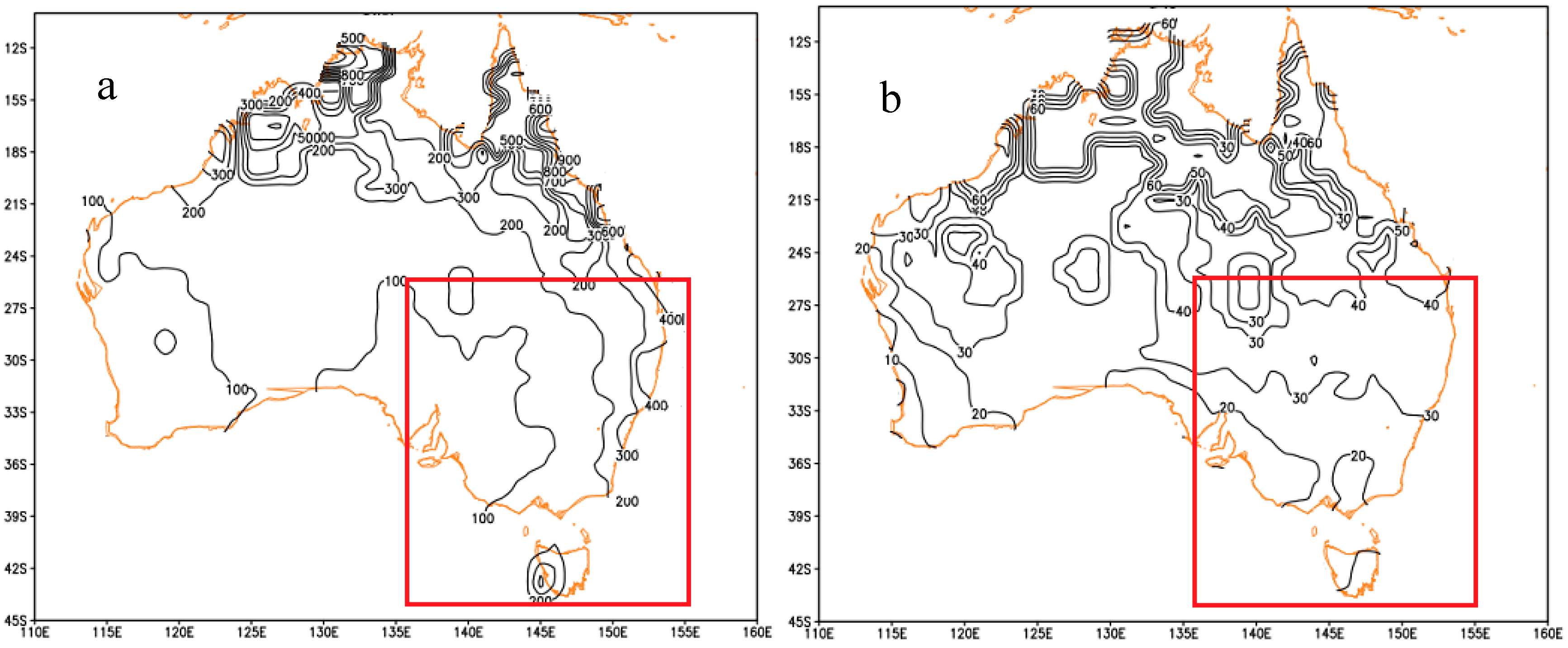
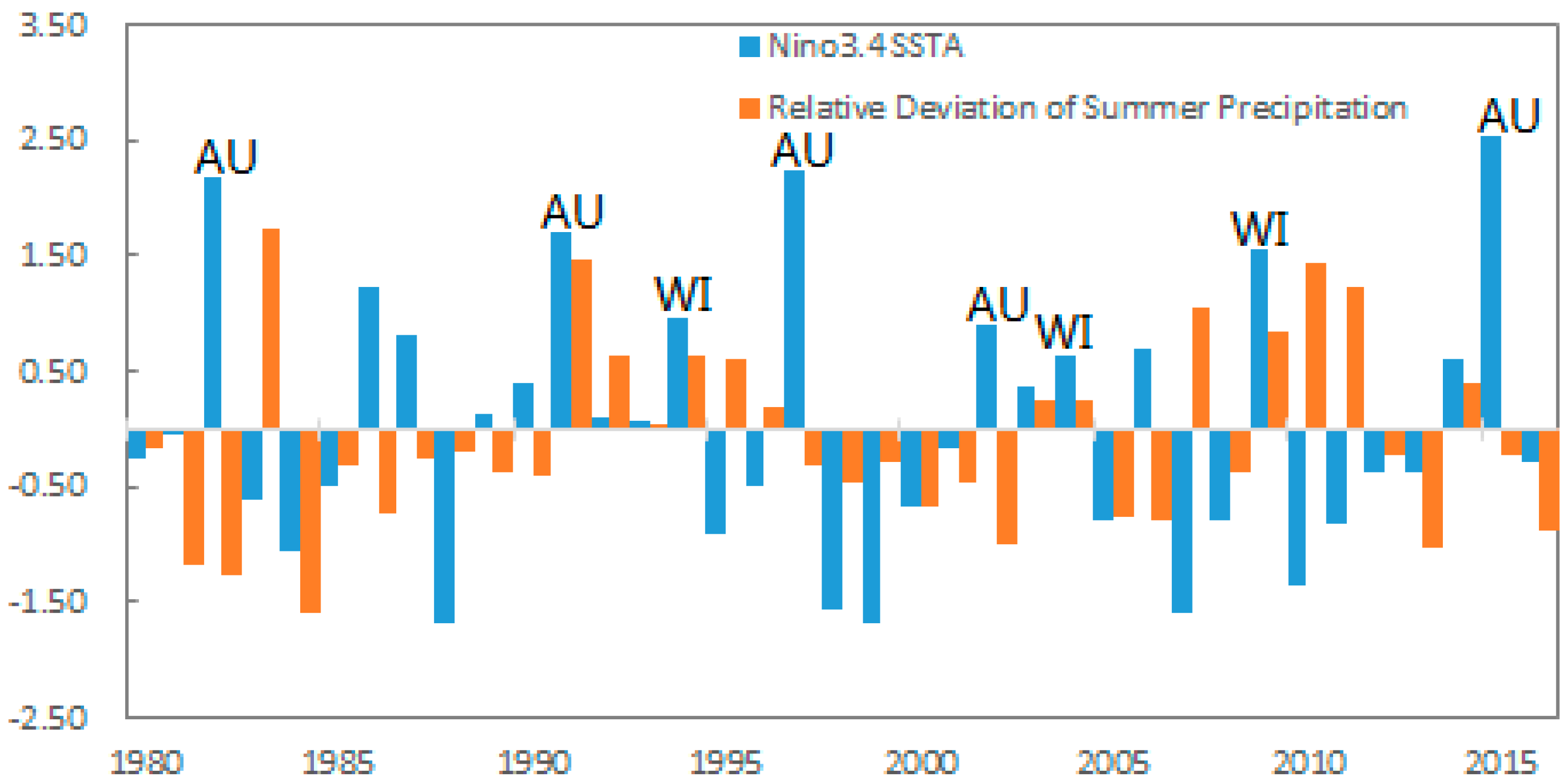

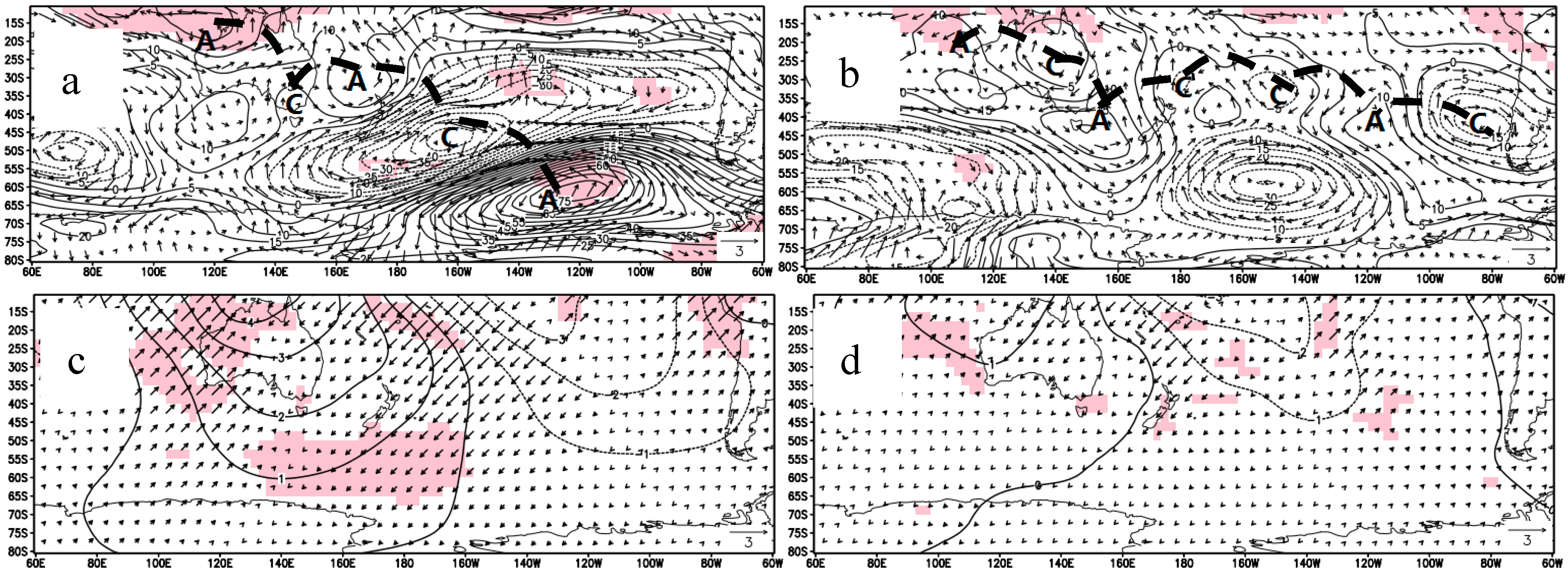
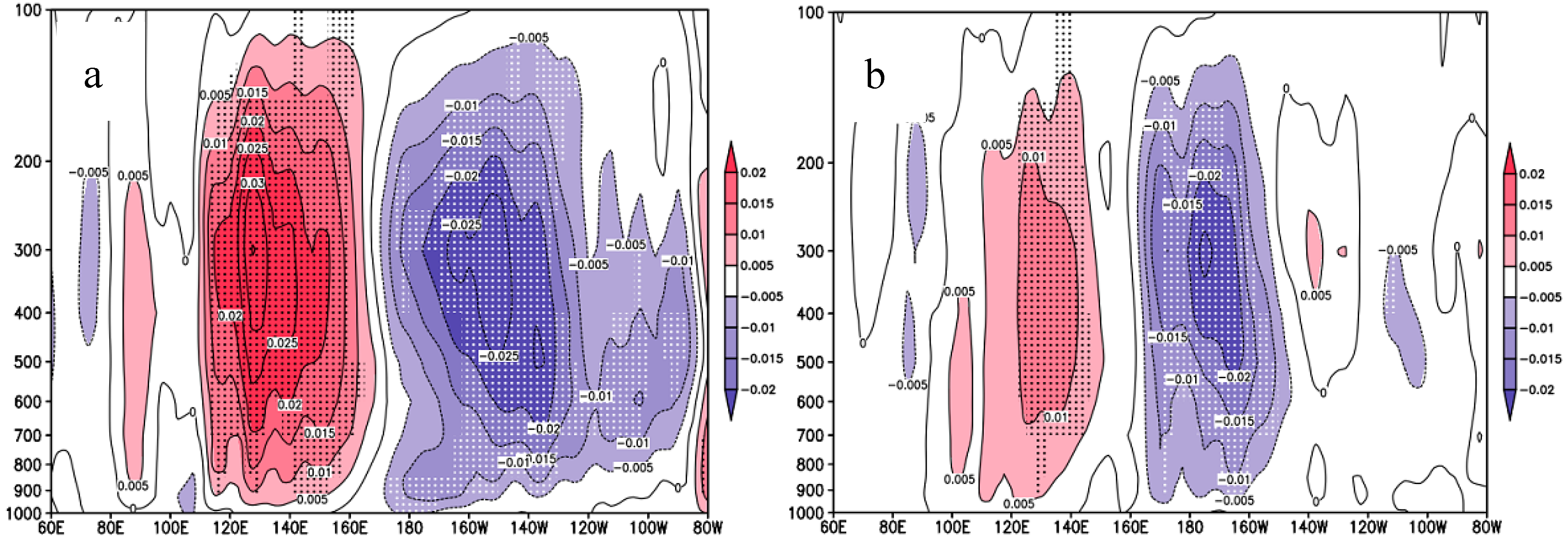
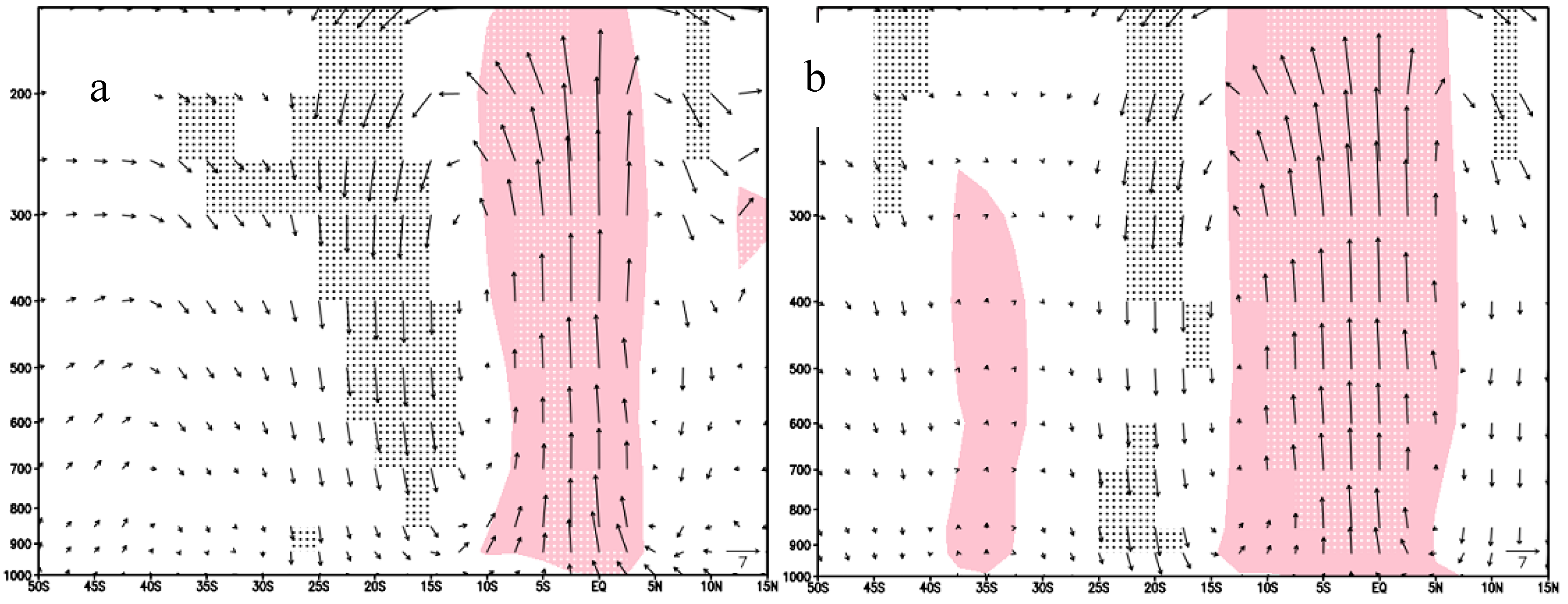

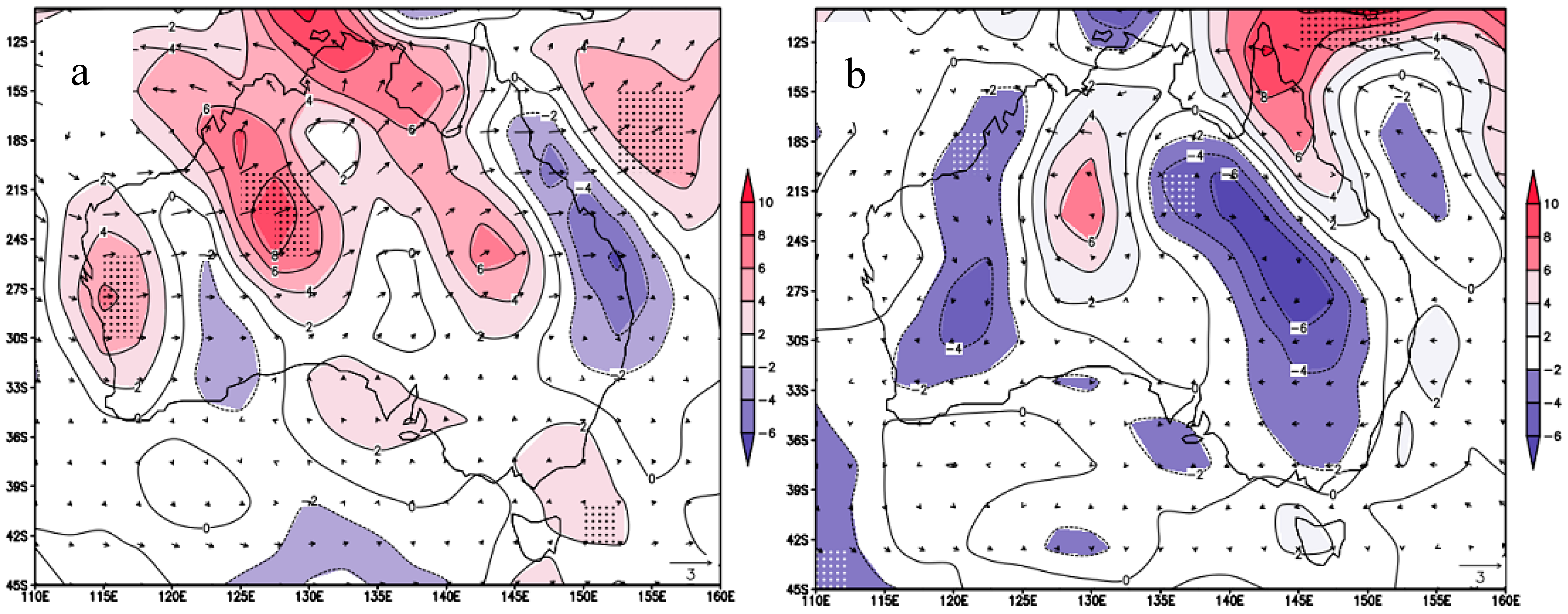
| Sequence | Duration | Length (in Months) | Onset_Time | Type |
|---|---|---|---|---|
| 1 | May 1982–June 1983 | 14 | April | AU |
| 2 | August 1986–January 1988 | 18 | July | WI |
| 3 | June 1991–June 1992 | 13 | May | AU |
| 4 | September 1994–February 1995 | 6 | August | WI |
| 5 | May 1997–May 1998 | 13 | April | AU |
| 6 | June 2002–February 2003 | 9 | May | AU |
| 7 | July 2004–March 2005 | 9 | June | WI |
| 8 | July 2009–March 2010 | 9 | June | WI |
| 9 | April 2015–April 2016 | 13 | March | AU |
© 2019 by the authors. Licensee MDPI, Basel, Switzerland. This article is an open access article distributed under the terms and conditions of the Creative Commons Attribution (CC BY) license (http://creativecommons.org/licenses/by/4.0/).
Share and Cite
Fan, L.; Xu, J.; Han, L. Impacts of Onset Time of El Niño Events on Summer Rainfall over Southeastern Australia during 1980–2017. Atmosphere 2019, 10, 139. https://doi.org/10.3390/atmos10030139
Fan L, Xu J, Han L. Impacts of Onset Time of El Niño Events on Summer Rainfall over Southeastern Australia during 1980–2017. Atmosphere. 2019; 10(3):139. https://doi.org/10.3390/atmos10030139
Chicago/Turabian StyleFan, Lingli, Jianjun Xu, and Liguo Han. 2019. "Impacts of Onset Time of El Niño Events on Summer Rainfall over Southeastern Australia during 1980–2017" Atmosphere 10, no. 3: 139. https://doi.org/10.3390/atmos10030139
APA StyleFan, L., Xu, J., & Han, L. (2019). Impacts of Onset Time of El Niño Events on Summer Rainfall over Southeastern Australia during 1980–2017. Atmosphere, 10(3), 139. https://doi.org/10.3390/atmos10030139





